Every employer knows the value of discipline in the workplace. It leads to the smooth management of an organization or company. In any workplace setup, the chances are that one or two employees may violate the set rules and regulations. While many employers tend to deal with discipline cases informally, there are cases where an employee gets involved in repeated or serious misconduct. In order to address such cases, it’s important that you make them aware of the consequences that follow their misconduct by creating a discipline policy.
What is an Employee Discipline Policy
A disciplinary policy is a document that highlights the steps that will be taken if an employee fails to perform their duties or engages in an act of misconduct.
Ideally, this document is often given by the employer to all employees before they start their employment. While they are not fully formed contracts, they help the employees be aware of the ramifications that follow if they break workplace rules.
Other names
Employee Disciplinary Policy can sometimes be termed Progressive Disciplinary Policy, Discipline Policy for Employment, Employee Discipline Policy, Disciplinary Policy for Employment, or Progressive Disciplinary Policy.
Free Templates
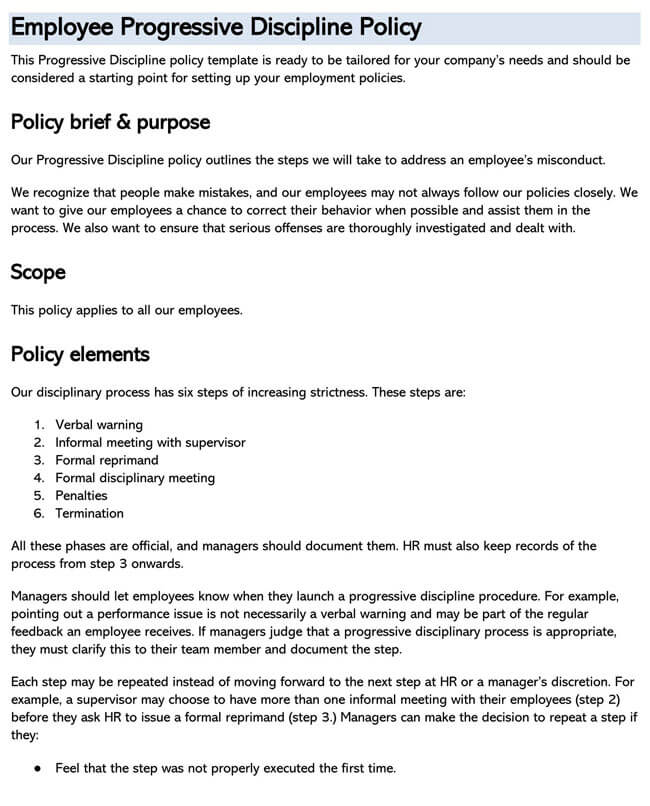
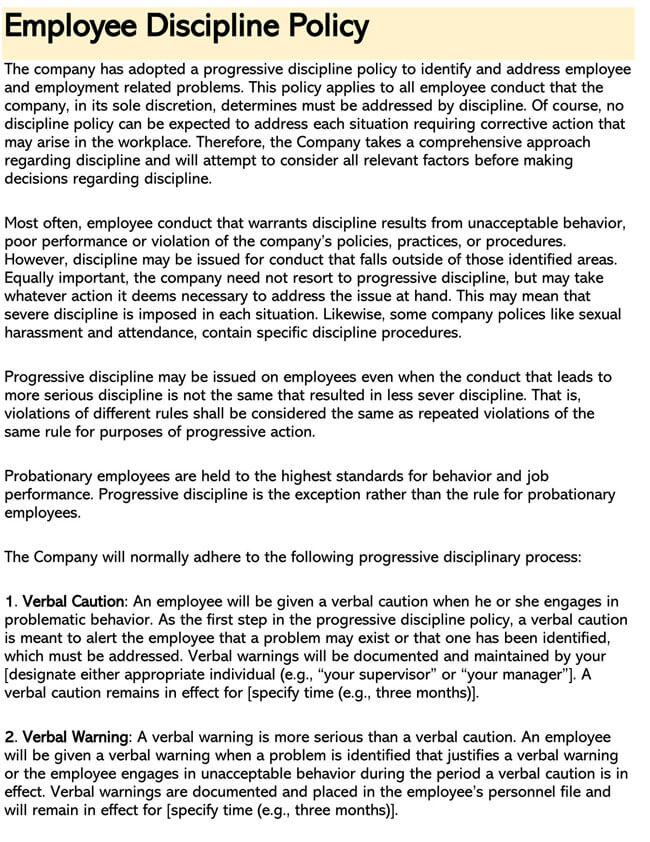
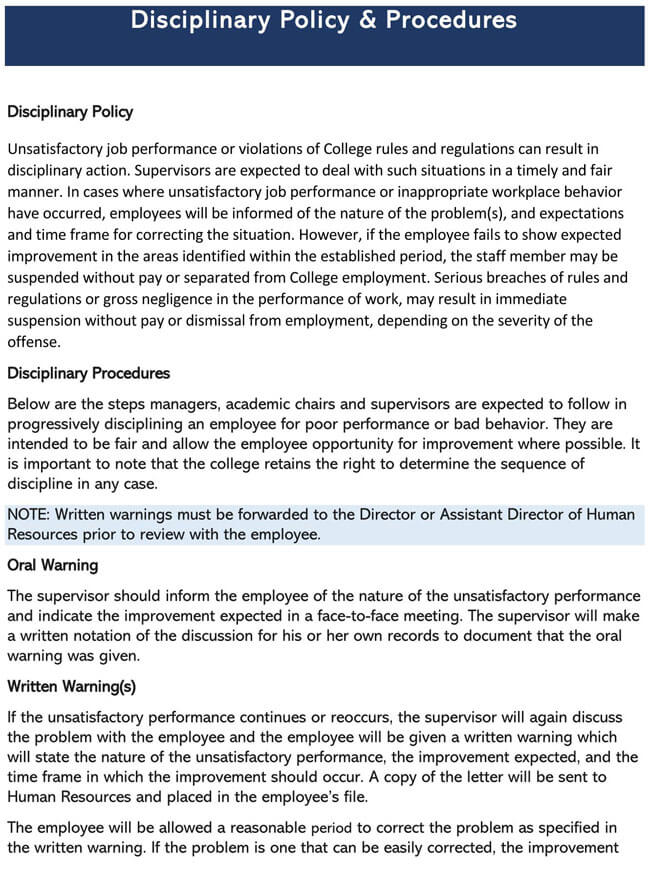
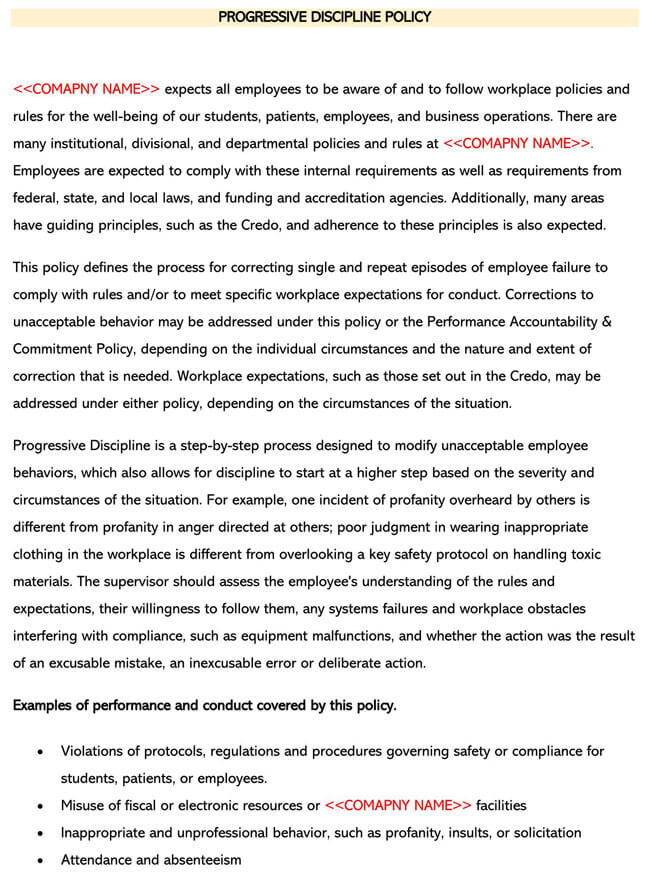
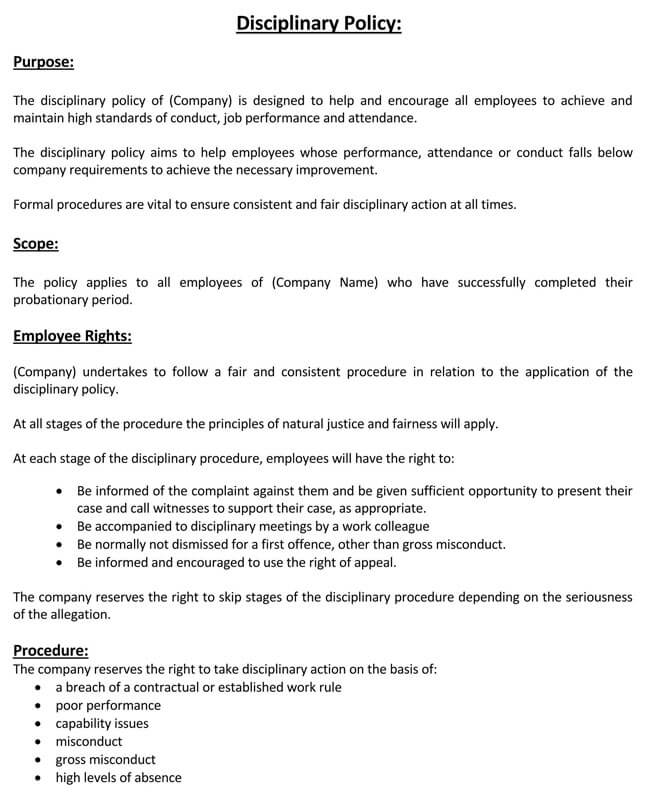
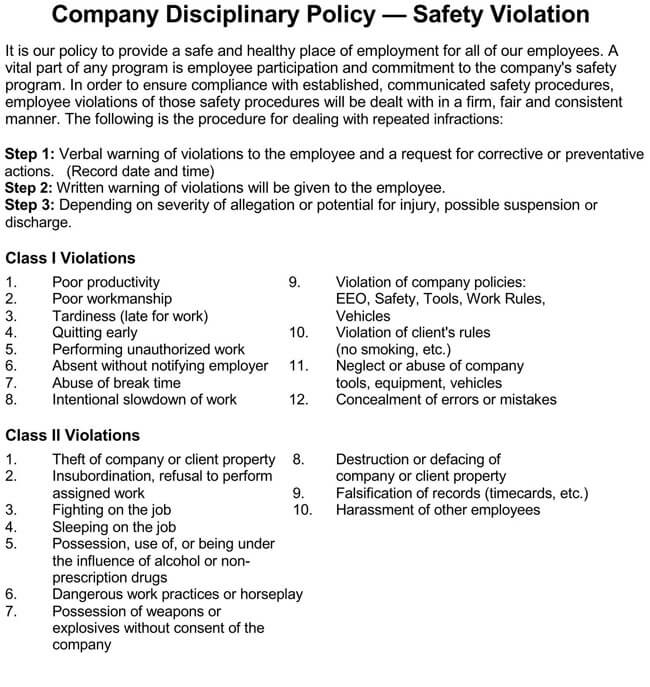
Disciplinary Policy Vs. Disciplinary Action Policy
While many people tend to confuse disciplinary policy and disciplinary action policy, the two do differ in meaning. A disciplinary policy usually aims at helping employees whose performance and attendance fall below the company’s requirements. On the other hand, a disciplinary action policy tends to identify and standardize procedures necessary when responding to incidents that are against company regulations.
Types of Employee Discipline Policies
Generally, there are three major types of discipline policies.
These include the progressive discipline policy, retraining, performance improvement plan, and reassignment explained below:
Progressive discipline policy
Progressive discipline policy is the most common policy type used by employers. Usually, it is designed to enable the employer to take disciplinary action according to the severity of the offense committed. In other words, it’s a type of disciplinary action that escalates from a warning due to minor mistakes to severe mistakes that could initiate termination. One common advantage of this type of disciplinary policy is that it provides room for training or rehabilitation.
For instance, if you feel that the employee is committing an offense or underperforming due to a lack of knowledge, you can decide to train or rehabilitate them to improve their situation.
Retraining and performance improvement plans
A training and performance improvement plan is a corrective approach that requires an employer to hold a one-on-one discussion with the employee who has violated company policy. Through such discussions, the two parties agree to address the problem by working on a training program as well as setting measurable goals to achieve. Also, they agree on the next course of action (which involves job termination) should the employee fail to improve their situation.
Reassignment or suspension
There are cases where an employee commits a serious offense, but the employer isn’t willing to terminate the contract for various reasons. They either get reassigned from their usual position or get suspended. These rehabilitative approaches are effective for skilled employees whose replacement comes at a cost. However, when the suspension is enforced, the employee must meet certain conditions for them to be reinstated.
Things to be Included in an Employee Disciplinary Policy
Disciplinary policy forms are legal documents. Therefore, you need to cover all the basics while writing them.
Typically, the form should contain the following:
Policy review
It describes the measures that will be taken if an employee misbehaves or underperforms. Also, note that your review should be precise and easily understandable.
Statement of at-will employment
Here, you need to let your employees know that they risk losing their jobs anytime should they fail to meet the company standards.
Forms of discipline
In this section, you will clearly state the actions that will follow if an employee underperforms or behaves inappropriately. Also, be sure to mention the type of discipline that will be enforced from one stage to the next. Last but not least, you can indicate the person responsible for enforcing various disciplinary actions. For example, if it’s the manager or supervisor, be sure to mention it.
Steps of disciplinary action
Here, you will explicitly explain the steps that will be followed when affecting the disciplinary process. Since the severity of violations may vary, it’s important to describe those violations that will follow a progressive disciplinary process. For instance, if an employee reports late to work, they will first be given a verbal warning, a written warning, and a suspension in that manner.
Employee’s right to appeal
Every policy should give the employee a chance to defend himself or herself. Sometimes they may fail to perform due to an underlying issue. For instance, they may be victims of workplace discrimination. Or, they may be lacking support from the management. In that case, this section helps them make an appeal as per their point of view.
Legal protection statements
This is the last but most critical section of your disciplinary policy. As an employer, you need to create your disciplinary policy appropriately to avoid being caught by the labor laws. Make sure you familiarize yourself with the local labor laws, such as the National Labor Relations Act, and Worker Adjustment and Retraining Notification, among others.
To stay on the safe side, make sure you include the following in this section:
- A statement that protects your right to fire employees at will.
- A statement that describes in detail the rule breach
- Evidence of previous discipline guidelines
- Evidence of misconduct.
5 Steps to Making a Disciplinary Policy
Creating an employee disciplinary policy can sometimes feel formal and time-consuming. Nonetheless, it’s very important that you follow all the due procedures to avoid legal claims. Alongside that, you also need to use a language that is easily understandable by your workers.
With that in mind, the following are steps you need to follow when crafting your policy:
Consult with your human resource department
If you are wondering where to start, the human resources (HR) department will help you organize the information you need to create the policy form. If you don’t have in-house human resources, you can use performance management software instead.
Consult an attorney
Employment relations lawyers will come in handy when crafting the document. The last thing you want is to be on the wrong side of the law. Therefore, you need to seek legal advice from your lawyer to ensure everything is covered. In case your company doesn’t have a lawyer, you can always hire one to help you out.
Mention all the company policies and rules
Once you have the correct advice from HR and your attorney, it’s time to describe in detail all the policies and rules of your company. Make sure you use simple and understandable language to make all the employees aware. Remember that if your employees don’t understand the policies well, the chances of misinterpretation will be high.
Discuss the steps of discipline
In clear statements, let your workers know what actions await any misconduct or poor performance. Also, describe the types of violations that are punishable and by what action.
Describe the termination process
In this section, you will state whether the disciplinary process will lead to job termination. If so, be sure you explain to employees what they should expect afterward. If the terminated employee owes the company something, you should indicate it.
Creating a disciplinary policy is essential for any company. It helps to take away the uncertainty from employees. Also, it helps your company to have a fair process for handling workplace misconduct or poor performance.








